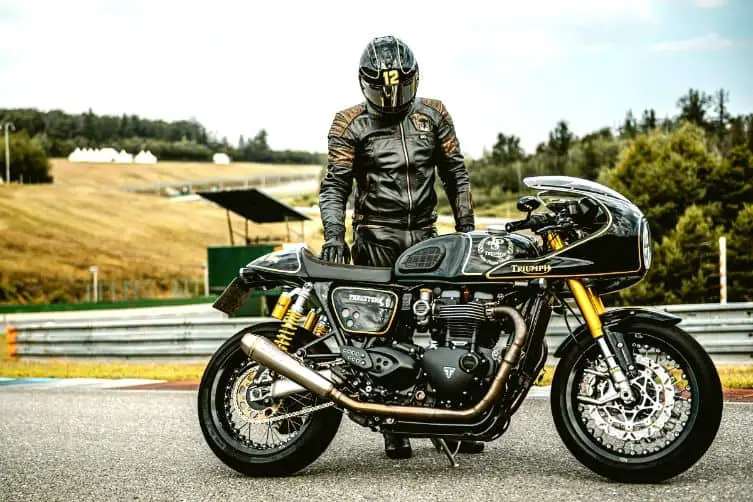Riding a motorcycle isn’t all that hard, but it may be tricky at first as you need to adapt to the motorcycle’s weight, controls and manoeuvrability. For a first-time rider, it may take between 2 and 8 weeks of daily practice to learn how to ride a motorcycle in a safe manner.
Overview
In this article, we discuss how hard it is to learn how to ride a motorcycle in detail and also some related topics that tie into this question. My objective here is to give a full answer that is helpful on various levels.
We will discuss the following:
- How hard it is to ride a motorcycle
- General discussion
- The most difficult things to learn
- The easiest things to learn
- Does the age of the rider make a difference?
- How long it takes to learn to ride a motorcycle
- The risks involved with learning to ride a motorcycle
- Which motorcycle you should choose for learning to ride
- What gear you need when learning to ride
How hard it is to ride a motorcycle
To give a complete answer on how difficult it is to ride a motorcycle, we need to cover a few topics that relate to the question and hopefully give you a full understanding.
General discussion
There are different aspects of riding a motorcycle and not all of them are hard to learn. In my opinion, most people would find it easy if they know how to ride a bicycle and how to drive a manual car. Knowing how to do either or both of these things will should make it a lot easier learning how to ride a motorcycle.
But let’s take a look at the different aspects of riding a motorcycle that you will need to learn:
- Balancing a motorcycle
- Understanding countersteer
- Using a clutch
- Using a turn-throttle
- Shifting gears
- Using the brakes
- Knowing the rules of the road
Balancing a motorcycle
Balancing a motorcycle is very similar to balancing a bicycle. The only real difference is that a motorcycle has a lot more weight which might make it more difficult at higher speeds. At low speeds, balancing a motorcycle might be easier than a bicycle. If you don’t know how to ride a bicycle, I suggest you start there because you need the skill of balancing on two wheels in order to ride a motorcycle.
Understanding countersteer
Countersteer is the way in which motorcycles are able to steer left and right by turning the handlebar in the opposite direction of where you want to go. While DanDanTheFireman has some good explanations on this topic, I recommend that you don’t think too hard about it as it may confuse you. Bicycles also turn by using countersteer, so if you can turn on a bicycle, you already have the required skill.
Using a clutch
The clutch is what disengages the engine from the drive that turns the wheel. Even though motorcycle clutch levers are very different from a clutch pedal on a car, the skill or instinct to engage and disengage the clutch at the correct time is still the same. Knowing how to use the clutch on a manual car can make it much easier to learn on a motorcycle.
Using a turn-throttle
No other vehicles besides motorcycles and scooters use turn-throttles so it might be a completely new experience for first-time riders. Yet, the basic skill of applying throttle at the right time when combined with a clutch is the same on a motorcycle as it is on a manual car.
Shifting gears
Unlike vehicles with automatic transmissions, most motorcycles have a manual gearbox that can be operated with the left foot. Being able to shift gears requires that the rider is able to operate the clutch and throttle with their hands and simultaneously operate the gears with their foot. Being able to drive a manual car can help a rider understand this but the way in which the gears are shifted is much different.
Using the brakes
First-time riders will be relieved to know that the brakes on a motorcycle is very similar to that of a bicycle. The only difference is that the rear brake is not on the left handlebar. Instead, it is operated by a pedal in front of the right footpeg. A motorcycle’s front brake is on the right handlebar just like a bicycle.
Knowing the rules of the road
While you need to learn how to control and balance a motorcycle, you might still need to learn how the rules of the road work if you don’t have a license for any other type of vehicle. If you already know the rules of the road, you will be able to consentrate more on the controles of the motorcycle and feel a bit more relaxed.
The most difficult things to learn
In my own opinion as an experienced rider who has taught other people how to ride a motorcycle, these are the most difficult things to learn as a first-time rider:
- Understanding countersteer
- Using a clutch
- Shifting gears
The easiest things to learn
Depending on what you may already know, these might be the easiest things to learn as a first-time rider:
- Balancing a motorcycle
- Using a turn-throttle
- Using the brakes
- Knowing the rules of the road
Does the age of the rider make a difference?
I have seen many people get on a motorcycle for the first time in various age groups and I don’t see the difference in the learning capability of young and older people. It really only matters what skills you have acquired before you start riding a motorcycle. These skills would be:
- Being able to ride a bicycle
- Being able to drive a manual car
- Knowing the rules of the road
Each one of these skills will make learning to ride a motorcycle easier and possibly increase your riding skills faster. While an older person might have accumulated more of these skills, it could reflect in the age groups and give a false impression that older people are able to learn how to ride a motorcycle much easier than young people. But it really just depends on what skills they already have.
How long it takes to learn to ride a motorcycle
Again, it depends on the skillset that you have built up over the course of your lifetime. The more of these skills you already have, the faster you should be able to learn how to ride a motorcycle.
These are the skills that will make learning to ride a motorcycle faster:
- Being able to ride a bicycle
- Being able to drive a manual car
- Knowing the rules of the road
For each person, the time it takes can be different but I estimate that a new rider should be able to learn how to ride a motorcycle in a safe manner between 2 and 8 weeks of daily practice depending on the skills they already have and which bike they are using to learn on.
The risks involved with learning to ride a motorcycle
There are a of risks involved in learning to ride a motorcycle and generally just riding a motorcycle on a public road. Ironically, many MotoGP riders don’t ride a motorcycle on public roads because their are too many risks involved.
These are the risks that you need to be aware of before you start learning how to ride a motorcycle:
- Head-on collisions can be fatal
- Rear-end collisions can be fatal
- Motorcycles can slide out in corners due to speed or incorrect braking
- Car drivers may not be aware of motorcyclists around them
- Motorcycles can slip on damp road markings
- Potholes on a road can easily cause mechanical damage or a crash
- Applying the front brake too hard can cause it to tip head-over
Which motorcycle you should choose for learning to ride
There are a few good motorcycles that you can learn to ride on but I have one favourite that I think is best for first-time riders. The Honda Rebel 500 is a good beginners motorcycle that is available all over the world. I would reccommend that first-time riders use this bike to learn on and I have more information on it in another article called Is the Honda Rebel 500 a good starter bike?
If ou already own a bike, you should just stick to it unless it’s too big or too heavey for you. An average 500cc road bike or a 250cc dual purpose bike is good to learn on. Although, you may find that the seat height on the Honda Rebel 500 is perfect for anyone.
What gear you need when learning to ride
You will definitely need some basic protection for yourself when riding a motorcycle. Most people can’t really afford the very best gear when they are just learning to ride, so here I’ll recommend some entry-level gear that you may consider.
Helmet
I recommend that you only consider full-face helmets with at least a DOT safety rating when looking at headgear. Full-face helmets offer the most protection over all other types of helmets and don’t cost as much as modular helmets.
These are my recommendations for entry level helmets:
- Bell Qualifier
- Fly Racing Street Revolt FS
- GMAX FF49
- HJC CS-R3
- HJC i10
- Icon Airmada
- Scorpion EXO-R420
Jacket
There are various types of motorcycle jackets that may or may not fit with the type of motorcycle you are riding. But you don’t need to worry too much about how you look, just make sure you are safe and the jacket you are wearing is able to protect you in a slide.
Boots
I always used to think that my steel-capped working boots provide good enough protection until I had a crash as the steel cap in my boot was ripped out during the accident. You need to wear proper motorcycle boots, but not the ones named ‘motorcycle boots’ on Amazon. Go to a decent motorcycle gear retailer like RevZilla, or FC-Moto if you are in Europe, and ask for their opinion regarding the safety of the particular boots you would like.
Final words
I hope this article was helpful to you in some way as I generally do a lot of effort in producing good informative content that is easy to understand and clearly outlined.
I always try to keep my articles interesting and informative. And I’m always thankful when they are shared on social media platforms or Pinterest.

